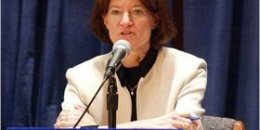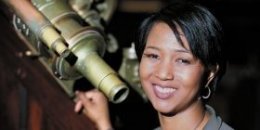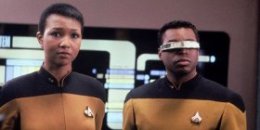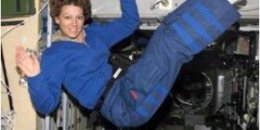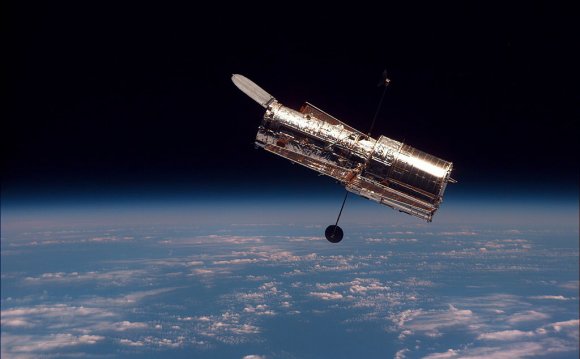
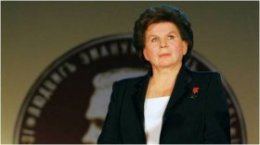 By Stacey Severn
By Stacey Severn
Identifying the top six female astronauts is a daunting task. So many outstanding women have made important contributions to human spaceflight, and we’ve gained remarkable insights from their efforts. It was difficult get the list down to just six.
Researching these wonderful women, I was humbled and awed. I finally whittled my shortlist down to the following six astronauts, listed in chronological flight order. They came from ordinary backgrounds like you and me, but they knew how to dream big and had the ambition to take it all the way.
Valentina Tereshkova, “First Lady of Space”
While in orbit, Tereshkova conducted biomedical & science experiments to learn about the effects of space on the human body, took photographs that helped identify aerosols in the earth’s atmosphere, and manually piloted the ship. The Soviets’ space missions were timed so closely that Tereshkova’s Vostok 6 capsule and the Vostok 5 actually passed within 3 miles of each other, and she spoke to her fellow cosmonaut, Valery Bykovsky, over the radio during her flight.
Tereshkova, whose call sign was “Seagull, ” was one of four females selected to the Cosmonaut Corps, and the only one from her group to ever fly in space. In her daily life she was a textile worker, but she was also an expert parachutist, a critical skill for cosmonauts flying those early missions. After re-entry and descent, the only way to get back to Earth was to eject at about 7, 000 feet with a parachute, because the Vostok capsules could not land safely.
“Of course, it’s a dream to go to Mars and find out whether there was life there or not.”
After Tereshkova’s successful mission, space travel remained exclusive to males for close to 20 years. (Svetlana Savitskaya and Sally Ride broke that streak in 1982 and 1983, respectively.)
After her flight on Vostok 6, Tereshkova studied at the Zhukovsky Air Force Academy, graduating with distinction as a cosmonaut engineer; she then went on to earn a doctorate in engineering.
Dr. Tereshkova eventually rose to prominence as a politician and remains politically active today. At age 76, on the 50th anniversary of her flight on Vostok 6, she once again displayed her pioneering spirit by raising her hand to take a one-way flight to her favorite planet, Mars. “Of course, it’s a dream to go to Mars and find out whether there was life there or not, ” Tereshkova said. “If there was, then why did it die out? What sort of catastrophe happened?” Given the opportunity, this amazing woman would undoubtedly help us find out.
Sally Ride, First American Woman in Space
Dr. Sally Ride is celebrated as the first American woman and youngest American astronaut to travel into space. She served as CapCom (capsule communicator) for the second- and third-ever Shuttle flights, and helped to develop the Space Shuttle’s robotic arm.
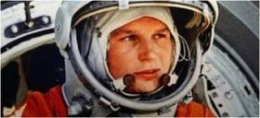 Ride flew two space missions (STS-7 and STS-61), both aboard Challenger, serving in the capacity of mission specialist. The purpose of these missions was to deploy satellites and perform pharmaceutical experiments. Ride was the first person to use the robotic arm to retrieve a satellite and the first woman to use the arm in space.
Ride flew two space missions (STS-7 and STS-61), both aboard Challenger, serving in the capacity of mission specialist. The purpose of these missions was to deploy satellites and perform pharmaceutical experiments. Ride was the first person to use the robotic arm to retrieve a satellite and the first woman to use the arm in space.
Ride spent several years working at NASA headquarters, where she founded NASA’s Office of Exploration. She also served on the Presidential Commissions that investigated both the Challenger and Columbia disasters.
She wrote or co-wrote seven books on space aimed at children, with the goal of encouraging children to study science. She became a physics professor and the director of the California Space Institute, and also led public outreach programs through NASA, including making photos from the ISS EarthKAM and the GRAIL MoonKAM accessible to middle school children.. Dr. Ride also created a company called “Sally Ride Science, “ which focuses on creating entertaining science programs with an emphasis on STEM learning for girls.
Sally Ride lost her battle with pancreatic cancer in 2012 at age 61, leaving an amazing legacy of inspiration and education as a result of her lifelong dedication to science and space.
Mae Jemison, First Black Woman to Travel to Space
Dr. Mae Jemison drew her spacefaring inspiration from Sally Ride and Nichelle Nichols, the actress who played Lieutenant Uhura in the original Star Trek series. After serving as a physician in the Peace Corps, Jemison applied to the Astronaut Corps. Her acceptance to the astronaut training program was delayed due to the Challenger disaster, but Jemison was finally selected and joined NASA in 1987.On Sept. 12, 1992, Dr. Jemison became the first African American woman in space on Space Shuttle Endeavour's second flight, which carried her and six other astronauts into space for eight days. She served as Mission Specialist and worked on the bone cell research experiment flown on STS-37, a cooperative mission between the United States and Japan.
Jemison left NASA in March 1993 and went on to teach at Dartmouth College. She also founded her own company, the Jemison Group, working on sustainable energy development projects and satellite-based telecommunications to facilitate health care delivery in West Africa. Dr. Jemison is a strong advocate for science, establishing an international science camp for high school students and working on the 100-Year Starship program.
As if all of these accomplishments were not enough, Dr. Jemison realized one other very special dream when she appeared as a guest on Star Trek: The Next Generation.
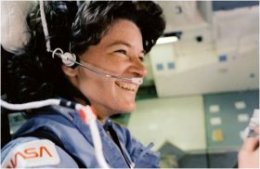 Eileen Collins, First Female Space Shuttle Pilot and Commander
Eileen Collins, First Female Space Shuttle Pilot and Commander
Piloting Discovery in 1995, Collins served as second-in-command for the United States’ historic rendezvous with the Mir space station. After taking time off to have her daughter, she returned to space in 1997, piloting a second trip to Mir aboard Atlantis. Her next mission was aboard Columbia, where she served as commander to the crew that deployed the Chandra X-Ray telescope.
Col. Collins’ final flight. STS-114, took place aboard Discovery in 2005, when Collins commanded NASA's "return to flight" mission to test safety improvements and resupply the International Space Station (ISS). During this mission, Collins became the first astronaut to fly the Space Shuttle through a 360-degree pitch maneuver, which enabled astronauts aboard the ISS to take photographs of the Shuttle's underside to ensure its safety.
Collins holds degrees in math, science, and space systems management. Since her retirement from NASA in 2006, she has made occasional public appearances as an analyst covering Shuttle launches and landings for CNN.
Kalpana Chawla, First Indian-born Female in Space
Dr. Kalpana Chawla was the first Indian-born woman and the second person from India to travel into space. She earned engineering and aerospace engineering degrees in India before settling in the U.S., where she earned her PhD in aerospace engineering and began her work for NASA at the Ames Research Center in 1988.
She was selected for the Astronaut Corps in 1994 and took her first flight (STS-87) aboard Columbia. During that mission she deployed the Spartan Satellite, which malfunctioned due to a software problem, necessitating a 2-man spacewalk to retrieve it.
After STS-87 Chawla worked at NASA on technical projects for the Space Station, and was selected to fly again as a mission specialist for STS-107, which eventually got off the ground aboard Space Shuttle Columbia in 2003.
Columbia carried a SPACEHAB module to the ISS, where Chawla and her fellow astronauts performed more than 80 experiments on microgravity, atmospheric dust, and astronaut safety.
The mission was successful until disaster struck during re-entry, when the orbiter’s wing overheated and came apart, leading to complete destruction of the vehicle. The damage to the wing had occurred upon liftoff, when a piece of foam damaged heat-resistant tiles that were critical to the integrity of the Shuttle’s structure during re-entry. All of the crew members were lost as the world watched, helpless.
After her death, Dr. Chawla was awarded the Congressional Space Medal of Honor, the NASA Space Flight Medal, and the NASA Distinguished Service Medal.
Barbara Morgan, First Teacher in Space
Barbara Morgan began her space career as an elementary school science teacher from Idaho. She was selected for the “Teacher in Space” program as backup to Christa McAuliffe, and the two trained together before McAuliffe’s ill-fated mission aboard Challenger in 1986, where all of the crew lost their lives shortly after liftoff The “Teacher in Space” program was cancelled after the Challenger disaster, but Morgan decided to press on, pursuing her dream of space. Her famous quote during that time was, “I want to get some stardust on me."She continued teaching science and also worked with NASA’s education division, contributing heavily to science education and serving on the National Science Foundation’s Federal Task Force for Women and Minorities in Science and Engineering.
In 1998, Morgan was chosen by NASA to become a mission specialist and underwent training at Johnson Space Center. She worked there as CapCom and also earned an amateur radio license, qualifying her to conduct radio communications with students on Earth as part of the ARISS (Amateur Radio on the International Space Station) program.
She was scheduled to be on a Columbia flight - the next mission after the disaster occurred. After the tragic loss of the Columbia crew, it took another four years before Morgan actually went into space. In 2007, she lifted off on Endeavor as mission specialist for the STS-118 crew. During the 13-day mission, Morgan was in charge of all payloads and operated a robotic arm to transfer a platform to the ISS. She also answered questions from students via satellite, something McAuliffe had hoped to do.
Now retired from NASA, Morgan remains a dedicated educator and works for Boise State University promoting STEM education. Of her time in space, Morgan says, “Yes, actually I did get some stardust on me. We all got some stardust on us."
